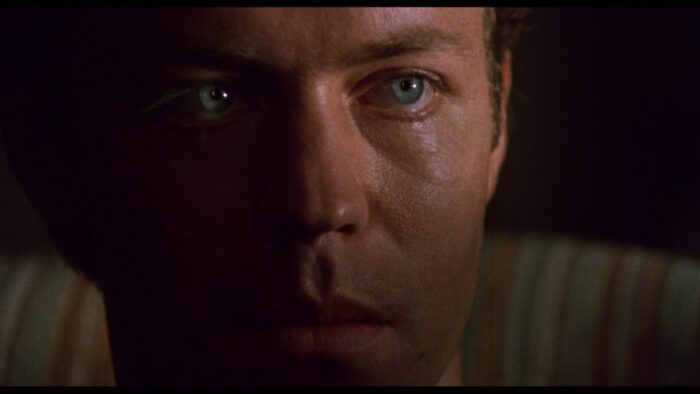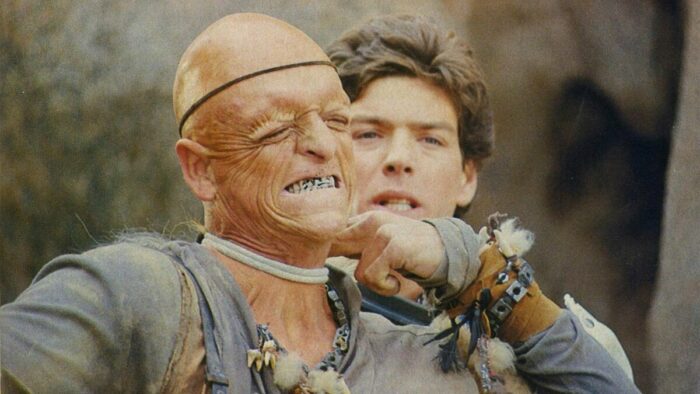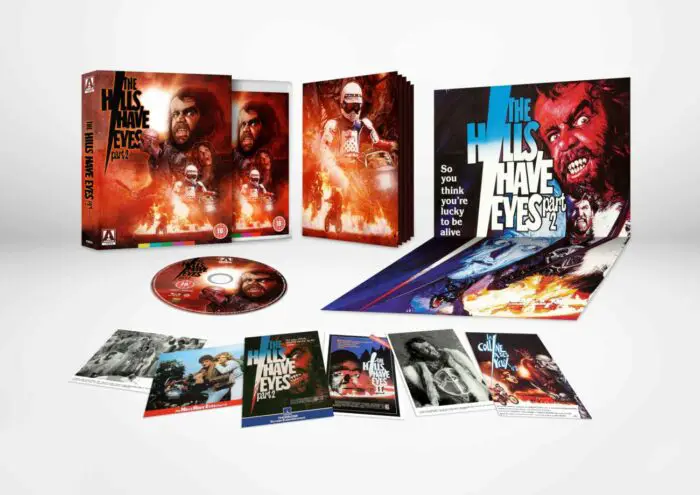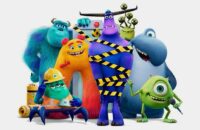Welcome to my column dedicated to the appreciation of physical media supplements: Feature Presentations. The goal of this column is not to say whether a film is good or bad, or worth picking up or not—I would like to highlight the discs that go the extra mile and provide film fans with enough tasty tidbits to satisfy even the hungriest of cinephiles. With all that out of the way, today’s article will focus on Arrow Video‘s limited edition release of Wes Craven‘s The Hills Have Eyes Part 2.
“Wait a minute,” you might say. “Arrow Video, again?” My last article looked at the 1986 horror/comedy House—itself released on disc by Arrow Video. I’ll do my best to break up the Arrow Video party for the next article, but no promises. Every boutique label will get its moment in the spotlight, but I felt like checking out Arrow Video’s presentation of The Hills Have Eyes Part 2.

Wes Craven is an icon in the horror genre due to classics like The Last House on the Left, A Nightmare on Elm Street, and Scream. When your filmography hosts more than one classic film, regardless of genre, you get more leeway than other directors out there. And don’t get me wrong, I love Wes Craven, but when you look deep into his catalog, you see a lot of questionable choices between masterpieces.
Every filmmaker has made a clunker or two in their lifetime, even the best of them. Steven Spielberg struck out with The BFG, Ready Player One, and Always. Martin Scorsese had misfires with The Color of Money, Bringing Out The Dead, and Casino. Yes, I went there will stand by the fact that Casino is an epic swing-and-a-miss. What I’m trying to say is that no director is perfect—sometimes you have to pay the bills, there could be pressure to make something you didn’t want to, or you just failed. It happens to the best of us.
Skimming through the history of Wes Craven, you see someone that either liked doing films that are questionable at best or just wanted to work. I’m not here to judge; sometimes those off-kilter movies can strike a chord (Shocker, for example) while others such as Vampire in Brooklyn seem to fail across the board. I understand this is my opinion, and I know there is a cult of people who enjoy Vampire in Brooklyn; the horror and humor didn’t click with me, though. What I am saying is that Wes Craven’s catalog is more suspect than what it appears. Films such as Deadly Friend, Cursed, My Soul to Take, and Scream 3 are prime examples.
Since we’re talking about Scream, this trendsetter of a horror film franchise was only one of two films that Wes Craven directed to a sequel. What was the other one? As I mentioned in the opening paragraph, today’s article will focus on Wes Craven’s The Hills Have Eyes Part 2.

As is customary with many Arrow Video releases, a limited and standard of The Hills Have Eyes Part 2 made their way to market. The limited-edition release houses the disc and additional materials in a rigid box with newly commissioned artwork. The non-disc supplements include a handful of lobby cards and a double-sided poster featuring the new artwork and the theatrical one-sheet on opposing sides.
The last limited edition supplement comes in the form of a 36-page booklet. The booklet contains one essay by Amanda Reyes, “The Hills Have Heart,” and an article by reporter Johnny Legend from his time on set, first published in Issue #37 of Fangoria magazine.
Reyes’ article is a loving tribute to a sequel that struggles for accolades. She defends the usage of flashbacks (more about flashbacks below), likes the characters, and finds enjoyment from beginning to end. As with others on the documentary and commentary, Reyes sees and understands the faults of The Hills Have Eyes Part 2 but sees unjust hate towards the sequel that she feels isn’t warranted.
The inclusion of Legend’s anecdotes is another fine touch by the folks at Arrow Video. Instead of having another article defending the sequel, we instead get a boots-on-the-ground account of a moment in time before the negative publicity around the film hit. Beyond the noting of filmed sequences, Legend’s set visit includes conversations Legend conducted with actors Janus Blythe and John Bloom plus makeup artist Ken Horn. The article takes you back in time and allows anyone who reads it the chance to join Wes Craven and his team out in the desert; before the negative reviews—just a film crew, doing the best they can.
The disc case features a reversible sleeve, similar to the poster. You can choose the new art or the original one-sheet wrap for your disc case. My taste is that I like to showcase as much as possible—as the rigid outer case presents the new art, I choose to place the original art on the disc case. That way, I get the best of both worlds.
We’ve finally made our way to the supplements on the disc itself. With a film as notoriously disappointing as The Hills Have Eyes Part 2, we should be lucky that we get anything at all. I will not say this is a loaded disc like some of Arrow Video’s other releases, but it’s nice to see a film as unloved by the masses get some love courtesy of Arrow.

Beyond the physical supplements I already mentioned, the disc’s meat and potatoes lie within two features: a commentary by The Hysteria Continues and a making-of documentary titled “Blood, Sand and Fire: The Making of The Hills Have Eyes Part 2.” Considering that most associated with it, Wes Craven included, distanced themselves from this film, it’s a minor miracle we got these features.
Starting with “Blood, Sand and Fire,” Arrow Video has provided an extended-length documentary featuring cast and crew from the film. Produced in 2019, “Blood, Sand and Fire” chronicles the origins of The Hills Have Eyes Part 2 through the unjust reputation it currently has. The documentary features interviews with actors Michael Berryman and Janus Blythe, composer Harry Manfredini, producer Peter Locke, and others. Each offers their thoughts and opinions on the film—rife with production issues.
“Blood, Sand and Fire” runs around 30 minutes in length but gets down to the meat, with little fat (yes, pun intended about this cannibal flick). Those interviewed understand that The Hills Have Eyes Part 2′s standing is low compared to the first film, but the documentary isn’t a bash-fest, either. Instead, we are privy to understanding how a shoestring-budgeted movie gets made and why a maligned flick like The Hills Have Eyes Part 2 graces cinema screens in the first place.
Documentaries like these are some of my favorites in that no one is pretending the movie is something that it isn’t. Beginning with Peter Locke, he discusses the success he shared with Wes Craven from the first film and how Swamp Thing, of all movies, was a contributing factor to getting The Hills Have Eyes Part 2 into production. From there, the cast and crew offer their insights—sharing adulation and disappointment with varying aspects of the sequel. The Arrow Video team did an outstanding job compiling enough participants willing to discuss the film and editing their comments for a tight, well-paced making-of. The final moments of the documentary focus more on Wes Craven. The discussion transitions into how he became the director all horror fans know and love. “Blood, Sand and Fire” shows Wes Craven emerging from the shadows of this infamous film to crafting the masterwork that is A Nightmare On Elm Street.
As I mentioned earlier, as the documentary came about in 2019, there are no comments to be found by Wes Craven, as he passed away in 2015. Even if The Hills Have Eyes Part 2 wasn’t a jewel in his crown, there is a love and respect that runs through the documentary to showcase his personality and perseverance. Would he have participated in this documentary if he was still with us? No one knows for sure, but “Blood, Sand and Fire” paints a beautiful portrait from a questionable subject.
We then have the aforementioned commentary track from The Hysteria Continues. We find a handful of commentators who express their enjoyment with The Hills Have Eyes Part 2. From the get-go, they address the elephant in the room that persists in this sequel: the usage of flashbacks. The commentators jump to the film’s defense and admit there are flashbacks, but the amount is substantially less than people remember.

As the commentary continues, the contributors alternate between defense and honesty. Some of the best tidbits come when discussing the early days of the production and the dire straits that pushed The Hills Have Eyes Part 2 into production. While the comments sometimes overlap the details in the commentary, both enhance the experience of understanding the film’s production. When taking the commentary and documentary into account, the full scope of The Hills Have Eyes Part 2 comes into focus with a director needing work and a film that wasn’t quite ready.
There you have it! The Hills Have Eyes Part 2 is no masterpiece but is not as much of a trainwreck that some assume. The period the film was made shows director Wes Craven at a crossroads in life. Coming off the disappointment that was Swamp Thing, Wes Craven took the money and, more importantly, the job to show production companies that he was still a director in demand. With that, he was got A Nightmare on Elm Street in production, and the rest is, as they say, history. Arrow Video’s disc gives ardent supporters of this film a reason to cheer, while those who look down on the sequel have the opportunity to understand why The Hills Have Eyes Part 2 exists. Either way, it’s a win-win for physical media fans and a worthy addition to anyone’s collection.



